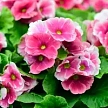
Primula
Early flowering
| Latin name | Primula |
| Homeland | Europe, Asia |
| Family | Primulaceae |
| Cultivation | simple |
| Location | open sun or partial shade |
| Temperature | optimal 7-9 °C |
| Watering | moderate |
| Flowering time | late winter-early spring |
| Height | 10-18 cm |
| Transplanting | in spring |
| Appearance maintenance | remove dead leaves and flowers |
Primrose, or spring primrose (Primula veris), is the most famous of the myriad species of the Primula genus. This is an unpretentious plant that is found wild in the central regions of Northern Europe and in Western Asia. It has no peduncle, oval leaves are covered with light fluff, the height of the stems is up to 18 cm, yellow fragrant flowers appear in spring. From this species, many hybrids have been bred, the flowers of which - a wide range of simple and complex colors-which creates an unusual decorative effect. The following types are of undoubted interest. The stemless primrose (Primula acaulis, or P. vulgaris) is a compact dwarf species that occurs naturally in forests and does not exceed 10 cm in height. The leaves are rough and bright green; the flowers are pale yellow in color. Primrose auricula-with a rosette of oval gray-green leaves. Fragrant yellow or purple flowers are collected in umbrellas on long peduncles.
Primrose, or spring primrose (Primula veris), is the most famous of the myriad species of the Primula genus. This is an unpretentious plant that is found wild in the central regions of Northern Europe and in Western Asia. It has no peduncle, oval leaves are covered with light fluff, the height of the stems is up to 18 cm, yellow fragrant flowers appear in spring. From this species, many hybrids have been bred, the flowers of which - a wide range of simple and complex colors-which creates an unusual decorative effect.
The following types are of undoubted interest. The stemless primrose (Primula acaulis, or P. vulgaris) is a compact dwarf species that occurs naturally in forests and does not exceed 10 cm in height. The leaves are rough and bright green; the flowers are pale yellow in color. Primrose auricula-with a rosette of oval gray-green leaves. Fragrant yellow or purple flowers are collected in umbrellas on long peduncles.
Cultivation
Flowered potted plants, which are usually bought from December to March, can be planted both in the open ground, and grown indoors on a windowsill or terrace. The duration of the flowering period depends on the conditions of the plant's environment. Usually in the rooms there is a high temperature, low light and insufficient humidity for primroses. However, if the pot is placed in a bright place away from heat sources, the plant can bloom for a long time in these conditions. When the plant is placed on windowsills, terraces or in gardens, flowering lasts for a long time, and the color of the plant does not change. the foliage is getting brighter. If indoor plants are planted in the open ground at the end of flowering, then they will bloom again next spring.
Location
Primroses like an open sunny place. However, partial shade is also great for them.
Temperature
The plant tolerates low temperatures, but not frosts. During the flowering period, the optimal temperature is 7-9 °C.
Watering
It is important to maintain a constant humidity of the soil, and you should not allow it to dry out excessively, or wet it too much.
Transplant
The operation is carried out in the spring at the end of flowering, using new pots of increasing size from time to time.
Care
Special care is not required for this plant-it is enough to remove withered flowers and yellowed leaves.
Reproduction
Spring primrose is propagated by seeds. Sowing is carried out from May to July in boxes, which are placed in a cool and well-ventilated place. It is important that during germination - it lasts about 4 weeks - the seeds are covered with a light layer of humus, and they should be protected from above with a thin piece of polystyrene. After 6-7 weeks, the first transplant is performed, and after another 4-6 weeks, the plants are planted in pots. A ready-made peat mixture is used as the soil.
Diseases
Primroses are sensitive to certain fungal diseases that cause rotting of the roots and root neck. Gray rot affects the leaves and flowers, provoking the formation of brownish wounds, covered with gray fluff. Due to infection with Romularia primulae on the leaves appear spots with a yellow outline, first yellowish, then brown. Primroses are also susceptible to peronosporosis, with transparent spots appearing on the upper side of the leaves; on the reverse side of the leaf, a whitish mold forms in the same places. Various symptoms: stopping plant development, leaf chlorosis, browning of leaf veins, deformation of the remaining small leaves and flowers indicate viral diseases. Pests such as aphids, mites and thrips cause deformity of leaves and flowers, and larvae of the flax moth and scoop lead to damage. primrose leaves and petioles. To control diseases and pests, special preparations are used. Good aeration and proper artificial irrigation also contribute to the prevention of fungal diseases.
Acquisition
From December to February-March, gardening centers and flower shops usually sell a variety of flowering primroses in pots with a diameter of 10-11 cm. It is recommended to choose plants that are just beginning to bloom with numerous buds and beautiful leaves, without spots and other painful symptoms.